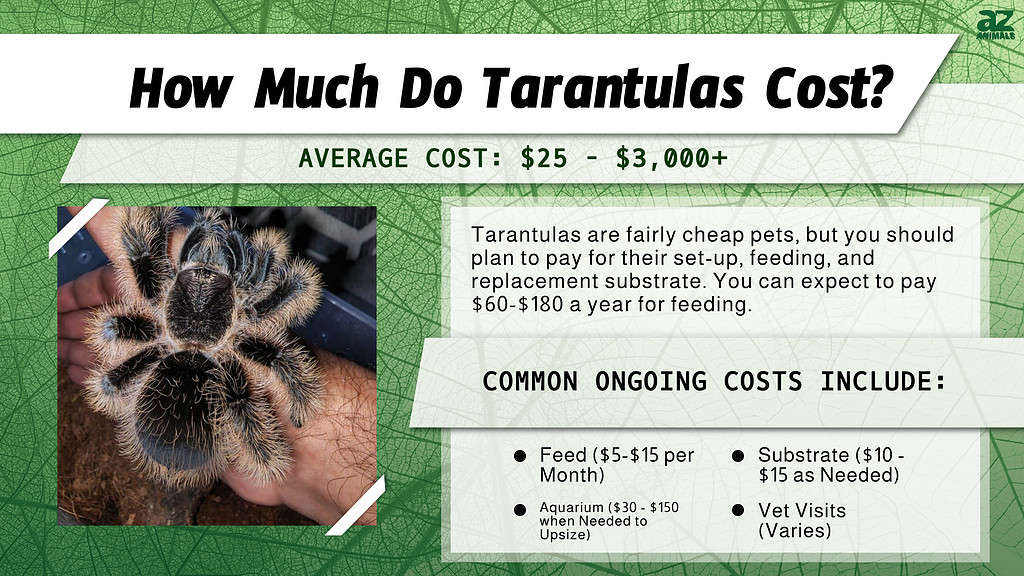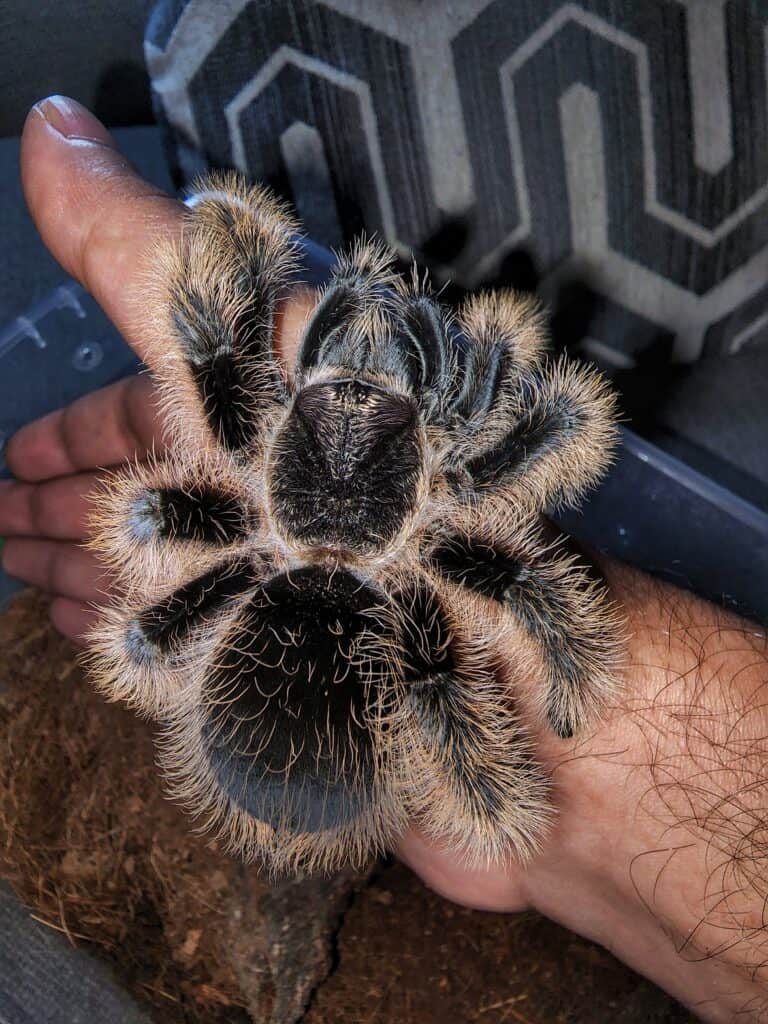Pet tarantulas require relatively little care when compared to other pets. They can be quite cheap to care for, but you should still plan for their expenses and ensure you can care for them properly before adopting.
Pet tarantula prices range from $25 all the way to $3,000+ for the rarest species. Most people will pay on the lower range of this spectrum. Additional start-up costs can range from $70-$250+ depending on the species and enclosure, and you can expect to pay $60-$180 a year for feeding.
Male tarantulas can live 10 years or more, and females have much longer lifespans, with some living into their 30s! Please keep this in mind before adoption.
Below, we’ll go over all of the common expenses for pet tarantulas, including adoption fees, start-up costs, and recurring costs.
How Much Does a Pet Tarantula Cost?

Pet tarantula prices range from $25 for common species to $3,000+ for the rare Mexican Jade Fuego Tarantula. Most people won’t be paying multiple thousands for these ultra-rare arachnids, however, and will instead opt for those around $25-$350.
Wild-caught adult tarantulas tend to be more expensive, while spiderlings (or baby spiders) are cheaper.
Captive breeding is seen by most as the humane way to adopt an animal, rather than taking it from the wild–but spiderlings can also be more difficult to raise and may die before adulthood. It’s important to do your research and ensure you can provide proper care for your spiderling before adoption.

The average person will pay anywhere from $25-$350 for their pet tarantula, but some species are more expensive.
©K Abejuela/Shutterstock.com
If you adopt your tarantula from a rehoming situation, their enclosure and other supplies may be included in the purchase price, which also tends to be lower than breeder prices. They’re also likely to be older and easier to raise.
Of course, you should always do your own research as well to ensure you provide appropriate care to your new pet. Some things your spider is sold with may not be suitable for them.
Tarantula Supply Costs

Tarantulas are fairly cheap pets, but you should plan to pay for their set-up, feeding, and replacement substrate.
©3,000 × 4,000 pixels, file size: 4.75 MB, MIME type: image/jpeg – License
Start-Up Costs
Your start-up costs are your one-time purchases that will last throughout your tarantula’s lifetime. Of course, you can set up a very simple enclosure or a very elaborate one, and your costs will often reflect that choice.
Below, I’ve put together a chart below that contains common expenses and their average costs.
| Aquarium* | $30-$150 |
| Substrate | $10-$15 |
| Accessories (plants, logs, and rocks for climbing and hiding) | $20-$50+ |
| Shallow water dish | $2-$5 |
| Spray bottle (depending on species and the humidity in your area) | $1-$5 |
| Heating pad (optional) | $10-$20 |
Most species of tarantula don’t need heat lamps but should be kept at temperatures between 70-80 degrees Fahrenheit. It’s important to research your individual species since some will need warmer environments.
Remember that you will also need to replace their substrate occasionally, though very infrequently.
*Aquarium size will vary depending on your tarantula’s size. You can buy a smaller set-up for spiderlings and expand as they grow, but this will be more expensive long-term than purchasing a set-up suited for them in adulthood.
While it’s important to research your individual species, 20 gallons or more is considered ideal for most tarantulas.
How Much Does it Cost to Feed a Tarantula?
Feeding a pet tarantula costs around $5-$15 a month. Crickets are the cheapest and most common tarantula food, but they can eat a variety of insects. Breeding your own crickets can make feeding your tarantula even cheaper!
Spiderlings will need to eat prey that is smaller than them, so you may need to offer small insects at first before working up to full-size crickets.
Do Tarantulas Need Veterinary Care?

There are vets who see tarantulas, but they’re rare to find.
©D. Kucharski K. Kucharska/Shutterstock.com
Most veterinarians don’t have the expertise to see spiders. However, some veterinary specialists care for invertebrates.
Before adopting your tarantula, research specialists in your area. It’s important to know how far you’ll have to travel for veterinary care or if there are specialists around you at all.
If you don’t have veterinarians who will see tarantulas nearby, you’ll then need to decide if this is a dealbreaker for you when it comes to adoption.
Tarantulas can have parasites, problems molting, or other illnesses that require veterinary care. However, most people do not bring their tarantula to the vet due to lack of access.
There is also no pet insurance available for tarantulas, as veterinary care for them is so rare. Therefore, it’s important to have a fund set aside for your tarantula’s care if you do plan to bring them to the vet when needed.
The photo featured at the top of this post is © K Abejuela/Shutterstock.com
Thank you for reading! Have some feedback for us? Contact the AZ Animals editorial team.






